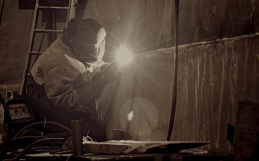When a long-time welder walks into a doctor’s office, the conversation isn’t pretty.
As welders, it’s always in the back of our minds that we’re messing up our bodies. Those fumes don’t smell good, and they can’t be good for the body. Look at the hands: stained, ashy, rigid and aged. In the worst cases, they shake and tremble.
Health issues in welding have been acknowledged, but not accurately. Scariest was in the early 2000s, when an Ohio judge blew the lid off cases of “paying for science”: it was revealed that welding companies paid $12.5 million to 25 organizations and 33 researchers to essentially dismiss the connection between metal fumes and health effects.
This was covered in detail by the Center for Public Integrity, which concluded that independent research has compromised people’s understanding of manganese, and how it affects welders’ health.
So we’ll explain it.
Manganese is a chemical element found in minerals, and present in tiny amounts throughout the body and many common foods. Eating it is great; breathing it is not.
It’s a neurotoxin. Consistent exposure to welders leads to symptoms similar to Parkinson’s. Most common are depression, numbness, memory loss, or something called “cock walk” (feeling like toes are digging into ground as you walk, making the simple act very difficult).
According to Science Daily, health issues related to manganese exposure were happening at levels lower than the OSHA standard. Meaning, it’s way more harmful than OSHA estimated. How much, exactly? Neurological symptoms appeared at exposure levels of 0.14mg of manganese per cubic meter of air — OSHA’s standard was set at 5mg.
This isn’t a rant against OSHA – they were just doing what they thought was best. What’s good is that we are aware of it, and now can go to work on it.
How to best protect yourself and your workers
To talk about protection, we must first talk about the nose.
The nose has a magical way of filtering the smoke and dust from welding machines. Think of it like a mesh screen on your back patio – it keeps most of the bugs out, except the tiny ones. Those tiny bugs, in the world of welding, can cause serious damage.
And thus your job is to protect your nose.
Respiration
You have several ways to keep harmful fumes away from your nose:
- simple masks (N95 or N99), which have exhalation valves to keep you cool inside, are best for most basic welding jobs
- for arc welding, you need more sophisticated masks – the 3M 2097 Particulate Mold Filter P100 has a layer of charcoal that absorbs fumes and vapors
- some welders opt for respirators, which are very effective but not always appropriate for worksites
Ventilation
Use a cooling fan, or open a window, to redirect breezes and fumes. Wth a fan, you have to set it up in a way that does not remove the shield gas around the arc
Avoid welding on coatings and paintings, which can create hazardous gases when they’re burnt. You can grind them away before you begin welding
Welding and the Eyes
An x-ray of welders’ eyes sometimes reveal small, dark-yellow, circular lesions that you don’t see in “ordinary” eyes. Since the last survey, they were present in 23.8% of welders.
Arc lamps are one of the few sources outside the sun that can produce UV light. It’s an insane technological ability of humans, to recreate heat which mimics the sun, but the downside is the damage it causes to the tissue of the eye. UV rays are invisible and often cause damage without you knowing it.
Exposure is what causes “arc flash” or “welders eye”, which is basically a sunburn to the eye. Sometimes it heals itself; other times, it causes an infection that can lead to far-reaching consequences.
Welders also risk damage from debris, vapors and chemicals.
You are best by protecting yourself from all of these. Your main options are:
- Welding shades: You need one that’s dark enough to look at the welding arc, and light enough to view the weld zone. Since different shades are used for different jobs, OSHA published their recommended filters.
- Welding face shields come with removable filters, to be used in different welding jobs. Some helmets even come with autodarkening lenses
Protecting the Ears
Noise is literally dangerous for your health. It acts similar to nerve damage – loud noises kill nerve endings in the ear. The more these are damaged, the more your hearing is decreased.
A study published by Science Direct found workers exposed to consistently higher noise levels reported higher blood pressures, as opposed to those who worked in quieter facilities. Thus, the safest noise level was recommended at 85dB (if your environment level is higher, then you’re required to provide workers with proper hearing protection).
Most welders complain about ear plugs. Your best bet is going with ear muffs from Peltor or Honeywell.
Protecting welders from negative health effects is an ongoing process. You’re melting metal – the human body wasn’t designed to interact with the chemical reactions that come from this.
That’s why it’s critical to monitor your symptoms and give your workers the best equipment you can find. This can be a lucrative, creative and rewarding profession, so long as you protect yourself.
Do you have questions about proper protection, or health effects of welding? Send us a note and we’ll get right back to you.





